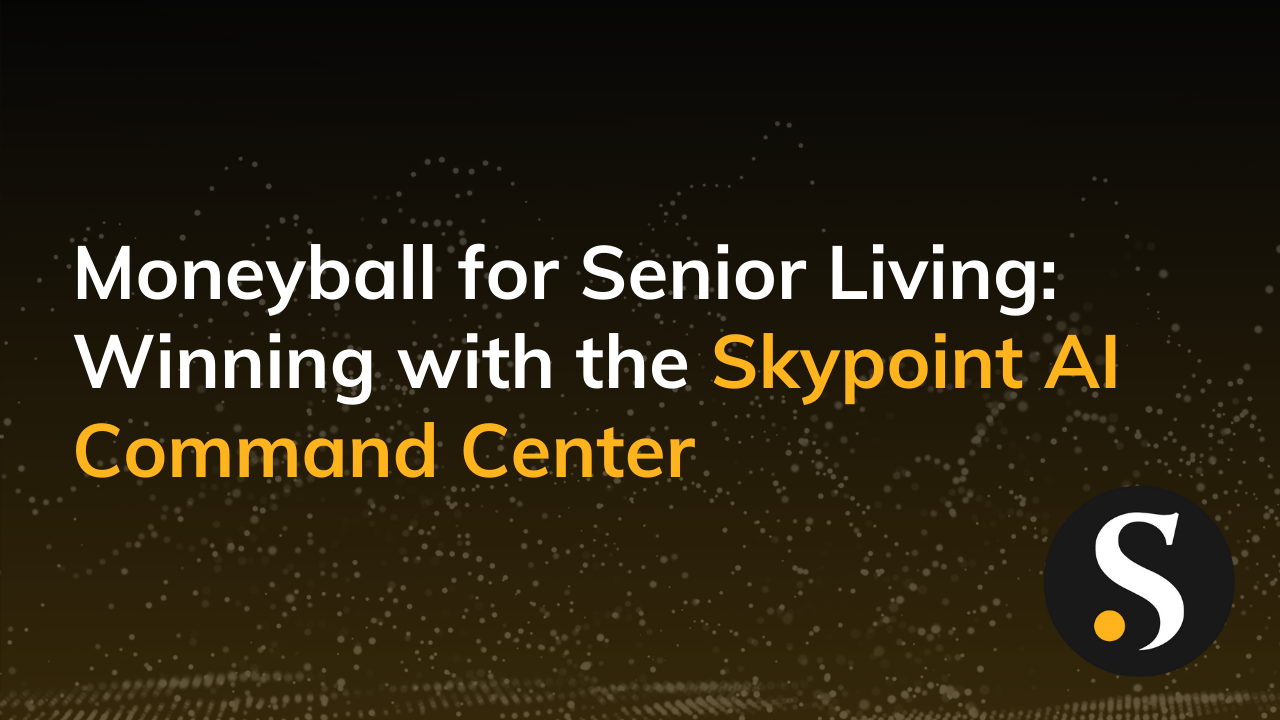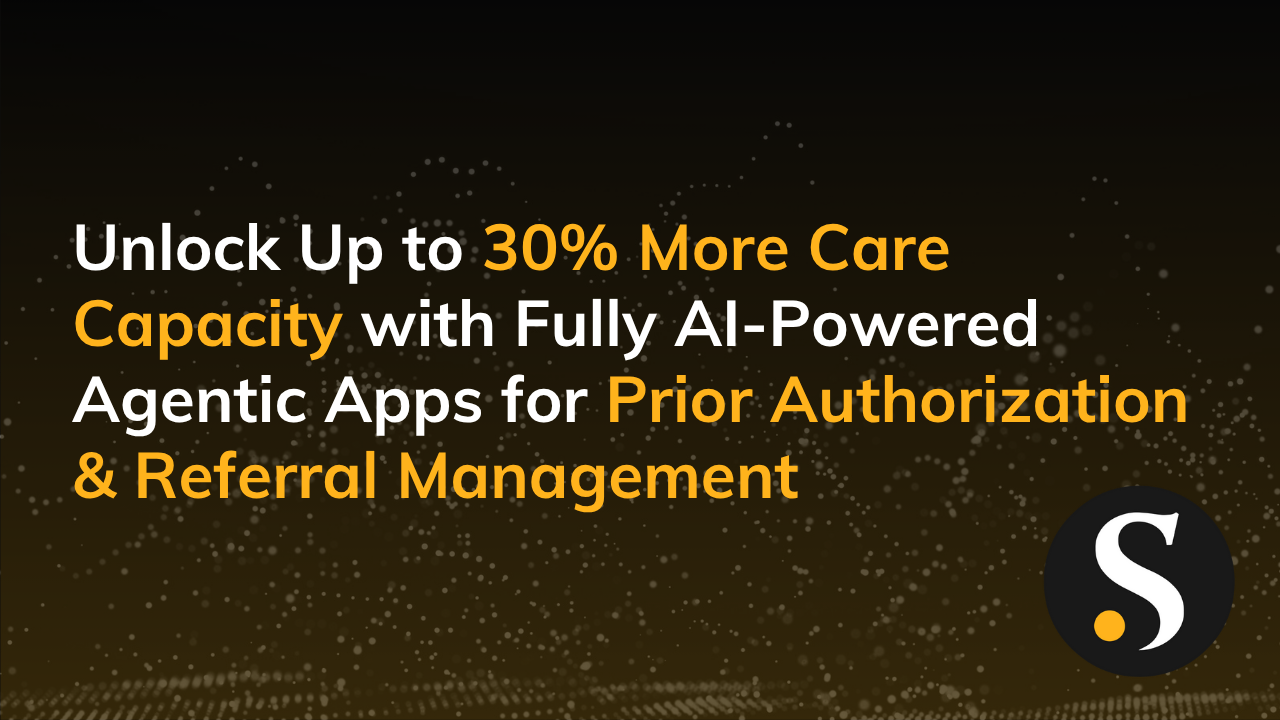No matter your role or industry, this webinar offers a wealth of knowledge from industry pioneers the forefront of generative AI, with a special focus on its implementation in healthcare and senior care. While the primary examples are from these sectors, the insights and use cases presented have broad applicability across various industries.
AI is transforming our world in dynamic ways, and this webinar recap illuminates key aspects of this rapidly evolving field. We had the privilege of hosting Nicole Kaufman, Chief Transformation Officer at Genesis HealthCare. With over two decades of experience in senior housing, starting with Marriott Senior Living (now Sunrise), Nicole has a comprehensive background. Her expertise spans sales and marketing, clinical services, programming, strategic development, operations, as well as new acquisitions and divestitures, offering a unique perspective on AI’s transformative potential.
Get to know these AI terms crucial for senior care
From ‘Unified Data’ ensuring quality AI outputs to ‘Generative AI’, transforming traditional chatbots into dynamic tools. watch
Unified Data: “Garbage in, Garbage Out”
Unified data is crucial for effectively utilizing AI. The common adage: “Garbage in, Garbage out” holds true in this context. AI’s effectiveness is directly tied to the quality of the data it processes. AI doesn’t inherently understand your organization or personal context; it relies on the data provided to it. Despite sensationalized headlines about AI’s capabilities, its true power lies in processing well-organized, clean data.
Many organizations have taken the initial step of consolidating their data but are still dependent on disparate vendor systems or ERP systems. The significance of truly owning their data is often overlooked. Not just storing it, but actively using it for valuable purposes like generative AI or advanced reporting.
It’s a common misconception that you need a highly mature data infrastructure to start with generative AI. The key is to identify a specific use case, unify the data related to that case, and follow an iterative approach.
Avoid the pitfall of the waterfall methodology, where everything must be perfect before progressing to the next stage. Focus on gathering the data for the chosen use case.
Skypoint’s success in delivering data warehousing and analytics solutions stems from this pragmatic approach. We tackle small, complete use cases without overreaching. When it comes to data and AI, it’s not about boiling the ocean – it’s about strategically heating the right parts.
What is Generative AI?
Think of generative AI as a super smart assistant that’s learned a ton from the internet. Unlike old-school chat bots that could only repeat the same scripted answers, generative AI can come up with new, smart responses on the fly. It’s like having a conversation with someone who really gets what you’re saying, no matter if you’re showing them a picture, a document, or just chatting.
Generative AI is the next level of those chatbots you’ve seen on websites, which were preprogrammed to say certain things. They’re supercharged by fresh info from outside, which helps them make even better sense of what you’re asking.
Big names like ChatGPT, Microsoft, and Amazon are all getting in on this, making it a big deal everywhere. They’re making it easier for AI to work across different apps and gadgets, so more people can use it.
What is an AI Copilot?
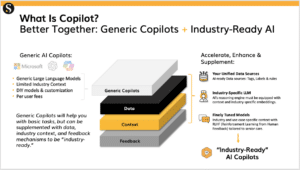
Jump to section
An AI copilot is like a helpful companion that knows a lot more than your basic chatbot. It’s not just about following a set of simple rules; it’s about having real conversations and figuring out complex scenarios and leveraging reason.
There are some generic AI copilots currently in use, from Microsoft’s Copilot to ChatGPT from OpenAI. They’re pretty good on their own, but they get even better when they’re given specific details to work with. Then there are custom AI copilots designed for specific industry use, that include:
It uses Your Data: When you provide AI your own data, like all your files or even just one document, it can understand your world better. That way, it can do more than just basic tasks—it can advise on specific actions to take based on your organizations policies & procedures.
It Focuses on Your Industry: The next important thing is training the AI on your job or industry. It’s like the difference between someone who knows a little about everything and someone who’s an expert in one special area.
It Leverages Your feedback: What you tell the AI helps it get smarter. Right now, AI copilots are kind of like the internet was when it was just starting—slow and a bit awkward. At first, the AI might seem like a newbie, not too sure about things. But the more you talk to it and correct it, the better it gets. Over time, as it learns from its mistakes and really gets to know your business, it becomes much more valuable.
“…when it (Copilot) was introduced to the industry, people didn’t know what to think of it. Yet now, every time we’re on a plane, copilot is activated and it’s not replacing the expertise. It just up levels that person’s ability to do their job. ..what we like most about the copilot at Genesis is that it creates the control that we need. And then it shows that we are able to take our work to the next level in a faster way than if we didn’t have a co-pilot.” watch
What is GPT?
Generative, pre-trained transformer. You’ll probably never hear somebody say it’s full name, but thank you, Sam Altman.
Beyond the general capabilities of GPT, Skypoint adds crucial elements: industry specificity. This means tailoring a large language model to function as a guardrail within specific sectors, such as healthcare, retail, hospitality, and more, each with their unique jargon and acronyms.
In healthcare, for instance, how does GPT understand the specific context and terminology without this industry-specific adaptation? We’ve dedicated considerable effort to training and fine-tuning our models to cater to sectors.
Our specialization in healthcare and it’s senior care sub industries means that when you interact with our AI platform, it’s equipped with in-depth industry knowledge. It’s designed to understand you’re operating within the senior care realm, providing relevant insights and information at your fingertips, tailored to your data and unique organizational context.
What is AI Context? How Does it Help Senior Care?
Understanding context is a pivotal aspect of generative AI. Technically, this involves something known as retrieval-augmented generation (RAG). This process enhances AI’s responses by integrating additional data or documents, moving beyond its base knowledge.
Fine-Tuning Through Human Interaction
Fine-tuning in AI is largely about reinforcement learning, a process driven by human input rather than machine autonomy. It’s about training the AI based on feedback – pointing out errors, clarifying ambiguities, or refining the prompts for better accuracy.
An interesting outcome of the generative AI era is its potential to improve how people communicate their needs. The more individuals engage with AI, especially in business contexts, the better they become at clearly articulating their queries and feedback, which benefits everyone involved.
The Role of Tagging & Metadata
Metadata is like the headers in an Excel spreadsheet. Just like how column titles (like first name, last name, phone number) provide context to the data, metadata acts as a descriptor, offering an additional layer of understanding. This extra layer is crucial for AI to accurately interpret and use the data.
AI Embeddings
In healthcare, embeddings might place terms like “flu” and “cold” close together on the map, because both are respiratory illnesses. This helps the AI to understand and relate these concepts more effectively in a medical context. Embeddings in AI are about integrating various components within the system. This is not about managing a single, undifferentiated mass of data but orchestrating a complex array of elements and agents in the background. When you interact with generative AI, you’re engaging with a sophisticated architecture that’s coordinating multiple processes to deliver the response you need.
Human Feedback
Feedback is how it all gets better. We’re in the dial up stage right now of AI. And when you have your business specific copilot, it’s like a junior analyst, it doesn’t really know a lot. It’s going to feel clunky. And it’s going to need that human feedback to get better. But it will grow with you and your organization exponentially faster than humans – and it never forgets. When it’s had time to be in the organization, have that longitudinal history, and gone through its failures just like we go through our failures – that’s where the value of Industry-specific AI will be recognized.
“managed care providers…They’ve been using generative AI for a long time in order to dictate the way care is delivered and skilled nursing facilities based on years of inputs that they can spit out length of stay rates, the Care Plan expectation, and I think it’s time for us to take some ownership in our data to be able to have the types of conversations that say ‘actually in our market and with our patient type and with our care delivery model, Here is what we know about the length of stay or expectations of care…” watch
The 2 Types of Data Used by Generative AI
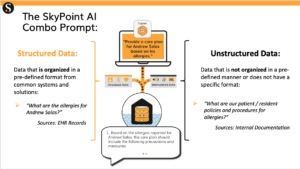
There’s 2 different types of data that’s feeding AI you can think about.
Structured Data
Think of structured data like an Excel sheet got rows. You’ve got columns. You got data. It needs to be structured in some sort of format to make value of it. And that structured data is what’s in your systems. You need a data layer over those systems to be able to really get some analytics out of it. But that whole data engineering and the data science piece of the world is what we typically are familiar with.
Unstructured Data
Historically, unstructured data has been akin to a locked cabinet, inaccessible and unused. Organizations often struggle with converting complex PDFs into structured data, a process that demands intricate patterns and computer vision technology. This complexity previously hindered the utilization of unstructured data, but this barrier is being dismantled with AI.
Recent advancements in large language models enable the ability to read, interpret, and make sense of content, even amid frequent context shifts. They can analyze an image, such as a cookie imprinted with a dog’s face, and apply layered reasoning to it.
Imagine the efficiency gains if we could search the actual content of all our SharePoint documents without the tedious task of manual tagging.
Our clients often ask about querying across both structured and unstructured data. “In anticipation of a new regulatory framework in 2024, how often were we compliant in 2023?” This requires deep, analytical work that typically consumes significant time and resources.
But with generative AI, you can likely get the answers you need in under 60 seconds.
Sharing knowledge, is really important. How can we share knowledge and abundance within organizations so that Nicole Kaufman’s files aren’t only for the people Nicole Kaufman wants to share them with, but that all of my intellectual capital that’s shared in this unstructured way makes its way into the greater good of the organization.. watch
Addressing Privacy & Security in AI
Prioritizing privacy and security is crucial. Tools like ChatGPT incorporate some elements of these safeguards, and it’s essential for commercial applications to do the same. The incident with Samsung, where sensitive non-public information was inputted into a commercial tool, highlights the risks involved. This underscores the growing demand for a secure, private AI Copilots within an organization, particularly in sensitive sectors like healthcare. Private AI fosters trust, as users can confidently interact with the AI, knowing their data is secure.
This approach allows for tailored access and security measures based on individual roles and needs. Like role-based security in data reporting, the system can intelligently determine access levels. For instance, a regional director would receive data pertinent to their specific region, rather than having access to nationwide data. This method ensures that each user only sees information relevant to their role, maintaining both privacy and organizational integrity.
Generative AI Uses Cases in Senior Care
Use Case 1: Financial Planning & Analysis (FP&A) watch
Problem: financial planning and analysis is characterized by its complex and diverse demands. Anyone who has interacted with finance teams knows this well. The endless questions and the myriad ways individuals or departments want to view data leads to a significant workload for data teams. The nuances of profit and loss statements, ledger entries, forecasts, and more, often hide the true extent of the effort required behind the scenes.
Solution: This is where generative AI, particularly large language models, comes into play as a solution. These models can perform the complex task of querying and constructing data analyses just like a human analyst, effectively writing SQL queries on the fly. With access to the right data, these models can handle the dynamic and intricate data requests that change daily.
Benefit: This capability frees up data teams to concentrate on more critical tasks like developing robust models, maintaining data quality, and ensuring proper data governance, rather than getting bogged down by the ever-changing demands of business data needs, that are likely to change daily.
When you’re the analyst who’s asked to create the SQL view for the ad hoc question for the executive on Monday, and you can’t get to it till Wednesday, and then you do it. And then by Wednesday they have already moved on from this. How frustrating is that? Generative AI is reducing that friction for everyone.
“…We’ve all been in Excel hell, and when the person who knows how to work the pivot table is off on vacation, and you’re having to get something quick for someone. You know that it takes a lot out of people to try to get different types of data into the hands of the folks that are asking for it. And so it’s important to reduce redundancy, increase efficiency and just have better work life balance for the people who are asked to produce reports at any given time.” watch
Use Case 2: Operational Efficiency and Productivity watch
Problem: Healthcare is chronically burdened with excessive administrative duties, leading to extensive overtime and widespread burnout. The pressing need to respond immediately to various situations adds to this strain. How we can utilize a supportive tool, like an AI co-pilot, to mitigate these initial moments of panic and enable healthcare workers to dedicate more time to actual patient care, rather than being bogged down with computer work and data entry?
Solution: The hope is that generative AI will move us away from using an EMR as a cash register, and use it as an enabling technology that genuinely assist in patient care. Ideally, this technology would allow healthcare providers to focus on listening to and understanding their patients, automatically handling the documentation process. This shift would enable nurses and doctors to concentrate more on discussing patient care instead of worrying about data entry.
Benefit: Ultimately, better patient management will lead to reduced healthcare costs. The goal is to reach a point where financial distress, such as the risk of homelessness following an emergency room visit, is significantly minimized. There’s a critical need to efficiently utilize technology to cut down on the unnecessary expenses and time currently prevalent in healthcare, bringing the focus back to effective patient care.
“We tend to start (with) How can the enterprise managers do their work better, quick, or faster? But honestly, it’s for the people who are closest to the patient that ultimately, this is really going to impact. And so if that doesn’t get us excited after the last 4 years and 3 years, and the burnout and stress that we’ve had because of covid. Then I don’t know what will…”watch
Use Case 3: Policies and Procedures & Knowledge Management watch
Problem: Understanding and implementing new policies, whether from state or federal levels, requires extensive effort. This often involves attending multiple training sessions just to grasp the policy changes. Similarly, in community or facility settings, the question is “How can one quickly and effectively understand and apply relevant policies?”
Solution: Skypoint had a customer who had to manage 100,000 documents, a task that involved manually opening, tagging, and renaming each document. This is where the power of a large language model becomes evident.
By comprehending the content of these documents, including policies and procedures, AI can track the evolution of policies over time. This capability is invaluable when aligning internal policies with new state or federal mandates.
Benefit: Typically, a whole department is dedicated to writing and interpreting policies, but with AI assistance, the focus can shift from writing policies, to implementing them and ensuring staff understanding.
“We have administrators who might have to have a crucial conversation, and they want might want some tips, quick and easy on whatever device we’ve provided that allows them to say: “Give me 3 ways to handle this based on my HR policy,” and it allows for them to be fueled with the tools that they need…It’s not only going to help us with the data side of the business, but also the people side of the business.” watch
For Skypoint’s client, when faced with the task of updating 100,000 employment documents for regulatory compliance, the alternative was either to incur fines or deploy a team to manually handle the documents.
With AI, this massive task was accomplished in just a few weeks, demonstrating the clear value of AI and fostering organizational buy-in and adoption.
How to build an AI strategy watch
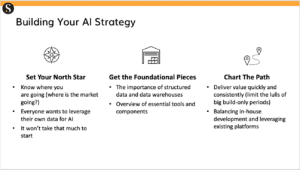
1. Set a North Star
Developing an AI strategy requires a pragmatic approach and setting a clear long-term goal, a North Star. In the rapidly evolving landscape of AI, having this North Star helps in navigating the unknown. Despite the constant changes in the field, as seen with companies like OpenAI, it’s crucial to anchor your strategy in a well-defined objective. A common aspiration among businesses is to leverage their own data for AI applications.
Starting with this goal, it’s important to recognize that realizing it won’t happen overnight. The North Star represents your destination, not your current position.
2. Unify Your Data
The next step involves laying the groundwork: ensuring data is unified and identifying specific use cases that can yield early successes. This approach helps in steadily charting the course towards your goal.
For leaders and grassroots builders, it’s vital to demonstrate quick and consistent value to gain organizational buy-in. This means selecting projects that deliver tangible benefits early on. Ambitious projects like building a data warehouse and rolling it out organization-wide might sound impressive, but if they take years to show value, you risk losing support.
3. Assess Your Internal Capabilities Realistically
Decide whether you can develop AI solutions in-house or if you need to collaborate with external partners for platform and expertise. Clear understanding of your organization’s strengths and limitations is essential for a successful AI strategy.
“…we definitely fall in the camp of feeling like we could build it ourselves… and it took us a minute to be open to the fact that we can be better if we bring in an expert in this space and bring in folks that actually can help shepherd us through how to use the information that we have available… So while there needs to be a path that includes some different phases. You definitely wanna ensure you’ve thought through the who and the when, when you get started.” watch
Key Takeaways
1. Get Your Infrastructure Data-Ready
AI requires a data ready infrastructure. You don’t need to be perfect. You don’t need to have the best data warehouse to start taking advantage of generative AI. And, whether it’s Skypoint or you build it yourself, you need an infrastructure that can get you to that point to support the data.
2. AI is the “Leapfrog” Opportunity for Industries to Catch Up
AI presents a significant “leapfrog” opportunity for the senior care sector. Many organizations in this field still rely heavily on tools like Excel and Access databases, often without having invested in advanced data warehousing or traditional AI technologies.
Generative AI is not only bringing technological advancements but also making them more cost-effective.
This is particularly beneficial for sectors like senior care, where budget constraints are a common challenge. The efficiency and value offered by generative AI mean that investments in this technology can yield substantial returns, making it an opportune moment for organizations in these industries to advance beyond their current technological limitations.
Don’t miss out on this chance to modernize and enhance your operations with generative AI.
3. Get Your Data Ready for Generative AI
The readiness of your data for AI is directly proportional to the demands you place on it. When you develop an AI-ready infrastructure, you’re not just preparing for generative AI; you’re setting the stage for a multitude of other functionalities. This infrastructure serves multiple purposes – from reporting and automation to supporting generative AI.
Consider this an investment in a versatile data layer for your organization, one that not only meets your current needs but also equips you for future technological advancements. By building this solid foundation, you ensure that your organization is prepared for whatever new innovations come next, making it a strategic move for long-term technological resilience.
4. Focus on Specific AI Use Cases; Set Realistic Expectations
Prioritize practical use cases and avoid trying to tackle everything at once. It’s important to set achievable goals regarding what generative AI can do for your organization. We’re in the early stages in the evolution of generative AI, so managing expectations is key.
The “if you build it, they will come” philosophy is not suitable for data-centric projects. Instead, target a specific use case, set clear expectations, and introduce the solution to a small user group first. Getting this group actively using AI is crucial. One of the advantages of generative AI is its ability to provide direct feedback from users.
Many organizations are adopting a phased approach to introducing new technologies, visualized as expanding concentric circles. Initially, they introduce these advancements to a core group of experienced and data-savvy users. These early adopters are adept at identifying and addressing any discrepancies or unrealistic outputs, such as evaluating the accuracy of reports on consultant utilization. Their insights are crucial for fine-tuning the system.
Following these initial adjustments, the technology is then gradually rolled out to broader user groups. This methodical approach, expanding from one level to the next, has proven to be an effective strategy for successful adoption.
Unlike traditional reports with limited interaction data, generative AI offers insights into what users are actually asking and seeking.
For those who have experienced the challenges of gathering requirements in the data world, generative AI offers a more straightforward way to understand user needs. Gather this feedback, iterate, and build on your successes. However, ensure that you approach this with a clear end-to-end strategy and a defined goal in sight.
“…it helps when you have someone who can almost anticipate, based on the research that they’ve done in the organization and the expertise they have in the industry… We value consultants. We value partners. And so with ChatGPT, we would spend money hiring people and getting folks in there trying to create our use cases and figuring out for us..” watch
Skypoint: Pioneering Generative AI in Senior Care
Skypoint has always been at the forefront of data and analytics. As early adopters of generative AI, we’ve been instrumental in integrating industry-specific applications into large language models and their use cases. Our journey has spanned a wide range of analytics, and now, generative AI is at the heart of our focus.
We’ve crafted our platform to seamlessly integrate essential infrastructure and tools into our customers’ systems, empowering them with the means to harness their data for competitive insights. As a longstanding Microsoft partner, we offer our solutions ensuring top-tier security, privacy, and compliance with certifications like, SOC2, and HIPAA.
Our ethos is encapsulated in our tagline, “chat with your data.” We believe in making self-service analytics as straightforward as conversing in natural English, enabling easy access to insights and task automation.
Our vision extends to a future where AI not only enhances efficiency but also contributes to a better work-life balance.
At Skypoint, we’re not just working with data; we’re shaping a future where AI returns valuable time to our lives. Reach out to schedule a personal demo with us, to see how we can help you “Chat with Your Data.”


